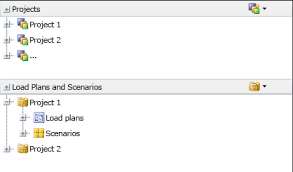To apply best practices for Oracle Data Integrator (ODI) development, consider the following guidelines:
- Project Organization:
- Organize your ODI projects and folders in a logical and consistent manner.
- Use meaningful names for projects, folders, and artifacts to enhance clarity and ease of navigation.
- Adopt a folder structure that aligns with your business processes and promotes reusability.
- Version Control:
- Utilize a version control system (VCS) to manage your ODI artifacts.
- Regularly commit changes to the VCS to track modifications and enable collaboration.
- Use branches for isolating development work, bug fixes, and new features.
- Reusability:
- Promote reusability by creating reusable components, such as mappings, packages, and procedures.
- Use ODI submodels to encapsulate common logic and make it easily reusable across projects.
- Store reusable components in dedicated folders for easy access and maintenance.
- Error Handling and Logging:
- Implement proper error handling and logging mechanisms in your ODI interfaces and packages.
- Use error handling techniques, such as exception steps, to capture and handle errors gracefully.
- Log relevant information, such as error messages, statistics, and debugging details, for troubleshooting purposes.
- Performance Optimization:
- Optimize the performance of your ODI interfaces and mappings.
- Leverage ODI’s built-in features, such as IKMs (Integration Knowledge Modules) and LKMs (Loading Knowledge Modules), to enhance performance.
- Utilize techniques like bulk-loading, parallel execution, and efficient SQL queries to improve data integration performance.
- Documentation:
- Maintain comprehensive documentation for your ODI projects and artifacts.
- Document the purpose, functionality, and usage of each artifact.
- Include relevant details, such as source-to-target mappings, transformations, and dependencies.
- Update the documentation regularly to reflect changes and ensure it remains accurate and up to date.
- Testing and Validation:
- Perform thorough testing and validation of your ODI artifacts.
- Test mappings, packages, and interfaces using representative data sets.
- Validate the data integration process, transformations, and business rules.
- Conduct integration testing to ensure seamless integration with other systems and components.
- Security:
- Implement appropriate security measures in ODI to protect sensitive data.
- Control access to ODI projects, folders, and artifacts based on roles and responsibilities.
- Encrypt and secure database connections and credentials.
- Performance Monitoring:
- Monitor the performance of your ODI interfaces and processes.
- Use ODI’s built-in monitoring tools, such as Operator and ODI Console, to track execution statistics and identify performance bottlenecks.
- Analyze execution logs and statistics to optimize performance and identify areas for improvement.
- Continuous Improvement:
- Continuously evaluate and enhance your ODI development practices.
- Seek feedback from users, stakeholders, and team members to identify areas of improvement.
- Stay updated with ODI features, enhancements, and best practices provided by Oracle.
By following these best practices, you can ensure efficient and robust ODI development, resulting in maintainable, reusable, and performant data integration solutions
SHARE
